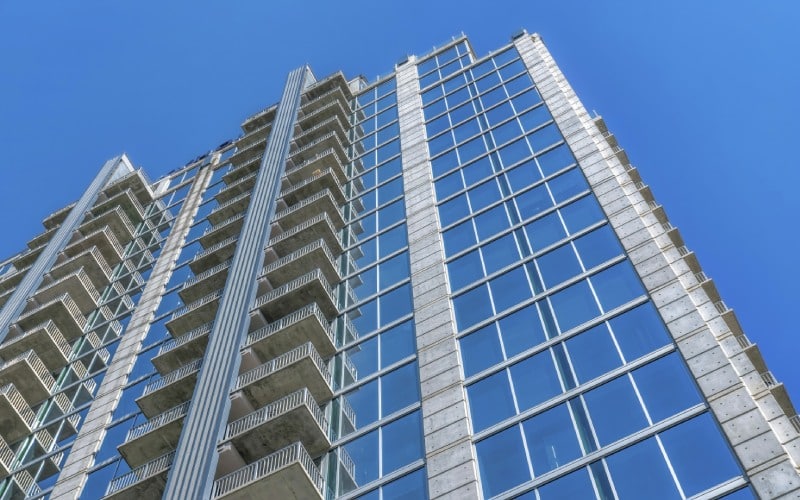500 Hood Road, Suite 320Markham ONL3R 9Z3
A fully funded reserve fund for condominium organizations is a critical concept aimed at ensuring that the condo organization has enough funds to cover forecasted repairs and maintenance according to expected needs.
While ‘fully funded’ may sound simple enough, effectively calculating and implementing the right numbers can be more complex. However, the basic goal – ensuring there is enough money to maintain condo buildings in good condition and pay for any required work – remains.
Condominium associations rely heavily on reserve fund studies to accurately forecast necessary maintenance and repairs, as well as to predict future costs associated with such endeavours. These studies play a critical role in ensuring that reserve funds are adequately prepared to cover forthcoming expenses. They involve meticulous assessments of the condition of common elements, estimation of their remaining useful life, and projection of repair or replacement costs over an extended timeframe, often spanning 30 or more years.
The reliability and accuracy of these studies are paramount. These form the foundation for budgeting decisions and the effective administration and management of reserve funds within condominium communities. Without dependable forecasts provided by reserve fund studies, it becomes challenging to allocate resources appropriately and ensure the financial stability of the association over time. As a result, investing in high-quality reserve fund studies is a significant advantage for financial planning.
Contrary to some might expect, achieving 100% funding doesn't mean having to have the entire sum for all future work stowed away in an account. Rather, it signifies being on track to accumulate the necessary funds by the time maintenance or repairs are expected to be due.
Essentially, a fully funded reserve balance is in direct proportion to the fraction of life "used up" for a given component. For instance, if a building component is expected to need replacement in ten years, and replacement costs are predicted to be $100,000, in five years’ time, or half-way through the period to replacement, a reserve fund balance would still be considered to be fully funded at $500,000, or half of the total cost.

However, condo communities will have various building components, with different expected related costs, all coming due at different times, which can make things more complicated. To be fully funded, the reserve balance will need to be on track for each of the repairs, so enough fund is available for each job as it becomes necessary.
Again, the condo organization does not need 100% of the funds for all of these, sitting and waiting in an account; the fund just needs to ensure that adequate funds are available whenever forecasted work becomes due.
Another complicating factor is estimating how much funds that are not being currently used can accumulate through interest or investment gains. Income from such sources needs to be regularly reassessed to ensure actual income matches predicted income, so the fund is still on track to be fully funded.
While costs for predicted work are also estimated, taking into account any expected increases, during periods of high inflation or industry changes, these estimated costs may be too low. Therefore, these numbers need to be reviewed and updated regularly to ensure a fund can still be considered fully funded.
These adjustments should be done in conjunction with regular condo reserve fund studies.
Maintaining a fully 100-percent funded balance can be challenging, especially during certain stages. Given that what constitutes being fully funded can also be a moving target based on changing factors, some condo organizations instead set a goal of maintaining 70% funded reserves available, instead. A 70% fund is considered strong, with low risks of special assessments or deferred maintenance.

While the Ontario Condo Act requires condominium corporations to establish and maintain a reserve fund to cover future repair and replacement costs, and requires at least 10% of the annual budget to go towards the reserve fund, it does not specify a target funding level.
However, achieving full funding of reserve funds is generally considered a best practice in condominium management, and ensures condo organizations are meeting their general requirement of providing an adequate reserve fund. When fully funded, the costs of maintenance and replacement are spread out over time, ensuring equitable distribution of expenses among all owners. It also enhances the marketability and value of condominium units, as prospective buyers are reassured by the property's financial stability and proactive approach to maintenance. It also demonstrates responsible financial stewardship, regulatory compliance, and transparency in condominium management.
Since a condominium reserve fund study is essential as a foundation for identifying future work needed, establishing timelines, and forecasting costs, it is critical to have comprehensive assessments with detailed reports and reliable predictions. ABSI’s skilled and experienced engineers provide the reliability and level of detail you need for effective financial management and planning.
Condo owners and board members may have heard the term “70 funded reserve”, and wondered what it meant, as well as whether it was a requirement or a guideline.
Condominium reserve funds set aside money specifically for significant future expenditures, such as major repairs or replacements of common elements such as roofs, elevators, parking structures, and HVAC systems. Without adequate reserves, condominium associations may struggle to cover these expenses, leading to deferred maintenance or imposing hefty special assessments on homeowners. Such assessments can strain residents financially and decrease the market value of units within the condominium.
To ensure that reserve funds are sufficient to cover future expenses, condominium associations conduct reserve fund studies. These studies involve assessing the condition of common elements, estimating their remaining useful life, and projecting the associated costs of repair or replacement over a certain timeframe, typically 30 years. Reserve fund studies provide invaluable insights into the financial health of a condominium community and help guide decision-making regarding budgeting and reserve fund contributions.
A 70% funded reserve means that the reserve fund holds 70% of the total estimated cost required for future major repairs and replacements. In other words, if the total projected cost of necessary future expenditures over the next 30 years is $1,000,000, a 70% funded reserve would have $700,000 available in the reserve fund. This percentage serves as a benchmark for the adequacy of reserve funds.
A 70% funded reserve is considered a strong one, with lowered risks of special assessments or deferred maintenance, ensuring condominium reserve funds are effective. On the opposite side, a 30% funded reserve, or less, is a weak one, with high risks of such issues.
Achieving a 70% funded reserve is considered a milestone for condominium associations, indicating a reasonable level of financial preparedness. It signifies that the association has taken proactive steps to ensure the long-term sustainability of the community and mitigate the risk of financial instability. However, reaching this threshold requires careful planning, disciplined budgeting, and ongoing monitoring of reserve fund contributions and expenditures.
Maintaining a 70% funded reserve involves regular review and adjustment of reserve fund contributions based on updated reserve fund studies and changing financial circumstances. Condominium associations must strike a balance between adequately funding reserves and minimizing the financial burden on homeowners. This often requires thoughtful decision-making and effective communication with residents regarding the importance of reserve fund contributions and the rationale behind budgetary decisions.
Failure to achieve a 70% funded reserve can have significant implications for condominium owners. It may indicate insufficient reserve fund contributions, inadequate budgeting practices, or a lack of foresight regarding future maintenance needs. It leaves the condominium organization at risk of being unable to pay for critical repairs. In such cases, condominium associations may need to explore alternative funding sources, such as special assessments or loans, to cover necessary expenditures, which can strain resident relations.

While the Ontario Condominium Act does not explicitly mandate a 70% funded reserve, it does require condominium corporations to make contributions to the reserve fund to ensure the long-term financial sustainability of the corporation.
One of the key provisions of the Ontario Condominium Act is for condominium corporations to allocate a minimum of 10% of the corporation's annual budget to the reserve fund. This provision aims to ensure that condominium corporations are regularly putting aside a portion of their operating funds so they are prepared for future major repairs and replacements of common elements.
Different jurisdictions may have varying requirements or recommendations regarding reserve fund levels.
The concept of a 70% funded reserve is a benchmark used to assess the adequacy of reserve funds in covering future major expenditures, and not a legislated requirement. However, while the Ontario Condominium Act does not specifically mention a 70% target, it emphasizes the importance of maintaining adequate reserve funds to address future repair and replacement needs, which the 70% mark achieves.
Achieving a 70% funded reserve would likely require condominium corporations to contribute more than the minimum 10% requirement. However, given the Act's broader objective of ensuring that condominium corporations are adequately prepared, condo boards should still aim for a 70% funded reserve to meet this broader objective. Going beyond the 10% contribution minimum helps achieve a level of reserve funding that provides the ultimate goal of financial security and stability for the community.
https://depositphotos.com/photo/business-concept-meaning-reserve-fund-sign-chart-sheet-businessman-working-517297000.html
A comprehensive reserve fund study is essential for precisely predicting necessary maintenance, timelines, and estimated costs, to give an effective baseline for measuring a 70% funded reserve against. Without accurate data and reliable projections, the 70% target lacks meaningfulness, and is just a number.
ABSI provides reliable, detailed reports based on thorough assessments, leveraging years of experience and expertise, so projections are highly valuable and effective. These reports are solid foundations on which to base budgeting and planning, so a 70% funded reserve provides the level of protection it is meant to.
A reserve fund study is completed to assess the long-term capital needs of a property, helping a condo board or other association create a cost-effective plan for maintenance and repair needs and ensuring the organization has sufficient funds to pay for costs as they arise.
As part of this proactive tool for property management, there are two key components: a physical inspection and a financial analysis. Together, these two components provide a comprehensive overview of the property's long-term capital needs and the financial planning required to address those needs. This helps property managers and boards make informed decisions about budgeting, plan long-term maintenance and repairs, and set reserve fund contribution amounts, in turn helping the properties to stay viable.
The first component is a visual inspection and physical assessment of the building or properties, to identify areas of concern. It provides critical information for effective reserve fund planning. By evaluating the current property health and condition, and anticipating wear and tear and projected replacement year, the study identifies key capital expenses that may be expected over the next 20 to 30 years.
Experienced, skilled assessors provide valuable predictions on likely major capital expenditures, and make ongoing maintenance recommendations, with expected costs, to extend the lifespan of building components; this minimizes the need for larger capital expenses. With quality information, financial planning for necessary repairs and maintenance is facilitated, so property managers and owners can make informed short- and long-term decisions.
The condition and life expectancy of all common areas, including roofs, exterior walls, windows and doors, HVAC systems, parking structures, plumbing and electrical systems, pavement and landscaping, plus other structures and systems, will be reviewed. Any deficiencies or concerns are noted throughout the site review. The condition of each component is evaluated to estimate its remaining useful life and project future repair or replacement costs.
Assessment methods may include visual inspections, non-intrusive tests, and, in some cases, more specialized techniques like infrared thermography or moisture meters.
This second component, the financial analysis, is integral to ensuring the long-term financial health and sustainability of properties. A comprehensive evaluation of the reserve fund's current status compared to future requirements means the financial health of the reserve fund can be assessed and potential shortfalls identified.
As a starting point, the current balance of the reserve fund is considered, giving insight into the immediate financial capacity available to address any needs.

A long-term projection identifies the work needed and estimated costs for future maintenance, repair, and replacement activities, as well as a predicted timeline for when the work will likely become necessary. This is based on the information discovered in the physical inspection, and a great deal of expertise and experience is necessary to create an accurate and effective projection. However, when this step is done well, it provides a strong foundation for property owners and others to budget from.
A depreciation report may be included, detailing the expected lifespan and depreciation of various components outlined in the physical inspection. It helps plan for replacements and ensures that funds are allocated appropriately.
A cash flow scenario analyzes the adequacy of funds over time. It takes into account various factors such as inflation, interest rates, and predicted increases in repair or replacement costs. The goal is to create a more accurate view of future financial needs, prevent unanticipated financial strain and avoid unplanned special assessments.
This forward-looking approach allows the necessary amount of regular contributions to be determined. This is the amount of money that has to be set aside regularly to ensure sufficient funds are available when major repairs or replacements are due. This amount will be compared to what is actually being saved.
After the required contribution amounts are identified, any shortfalls in funding become apparent. As a result, the analysis may also provide recommendations for adjustments to the contribution rate. A temporary or permanent percentage increase in reserve fund contributions from unit owners may be proposed if necessary. On the other hand, if there is a surplus, there may be recommendations on how these surplus funds could be used to optimize property management.
Choosing a high-quality engineering firm experienced in reserve fund studies means you can gain optimal benefits. A good company with the proper expertise will provide detailed assessments, accurate projections, and actionable insights, leveraging experience, technical proficiency, and industry knowledge. The quality of the study is enhanced to provide stakeholders with the most reliable and informed basis for strategic decision-making.
ABSI offers in-depth inspections and clear, actionable reports, offering valuable planning guidance from seasoned engineers. Our reliable, detailed 30-year projections empower property managers, boards, and other stakeholders with essential information for effective, forward-thinking budgeting. We help increase the longevity and financial resilience of your properties.
While some building organizations believe low maintenance costs are the way to save money and maintain robust finances, cutting maintenance costs excessively can backfire and lead to significant repair bills in the future. What’s more, many organizations are then not financially prepared for these urgent costs. A key solution is assessing potential future maintenance needs and carefully allocating funds for critical capital projects, so work is completed more proactively, and money is available for needed work - when it is needed. Having an effective fund can also contribute to the overall value of your condos.
A Reserve Fund Study is a comprehensive planning tool that assesses the anticipated major repair and replacement needs of a condominium corporation's common elements. These common elements include vital components like roofs, windows, garage structures, elevators, plumbing, electrical systems, pools, and more – essentially, any shared infrastructure that benefits all unit owners. The primary purpose of the reserve fund is to accumulate funds over time to cover the future costs associated with the maintenance, repair, and replacement of these essential elements.
The Condominium Act, a governing legislation in many jurisdictions, mandates that all condominium corporations establish a reserve fund separate from their day-to-day operational funds. This reserve fund is designed to serve as a financial buffer, ensuring that the condominium corporation is adequately prepared for major capital expenditures. The Act outlines the types of common elements that must be included in the reserve fund study, ensuring a comprehensive assessment of the corporation's financial needs.
In Ontario, regulations dictate a minimum frequency of reserve fund studies. The goal is to help ensure properties forecast potential major repairs and replacements and mitigate the risks of unanticipated repairs, while ensuring there is enough money for such work.
To that end, the Condominium Act requires that reserve fund studies be completed within certain timeframes, so that condos are adequately prepared and their residents protected.
An initial comprehensive reserve fund study (Class 1) is required within the first year of a condominium building being registered. This type of study may also be required after major repairs or replacements or if there are suspected issues with the original, initial study.
After that, a Class 2 or 3 study is required every three years to provide an update to the study. Class 2 studies require a visit to the facility, while a Class 3 does not require one. Every three years, you alternate which type of study is completed, switching from one study to the other every time.

While the Condominium Act establishes a minimum standard for reserve fund studies, there are situations where it is an advantage for a condominium corporation to conduct more frequent or additional targeted studies.
As a condominium complex ages, or if it has experienced significant wear and tear, such as after a severe weather event or other damage-causing incident, an update to the study may be prudent, even if it is not required by regulations for a couple of years.
An updated reserve fund study is also beneficial to help condo corporations stay on top of changing real estate markets and other trends, helping them adjust to fluctuating property values, construction costs, and other market trends. This means financial planning stays effective and proactive, mitigating risks and ensuring long-term sustainability.
The goals of these studies are to identify potential issues earlier and ensure there are adequate funds to meet ongoing maintenance and repair needs, so it is helpful to consider these studies with this in mind, as opposed to a mandatory event. Instead of putting a study off until the last possible moment for compliance, consider having one completed when it makes sense or could be beneficial. This leads to safer, more cost-effective, properties and operations and a more attractive condo for prospective residents.
In the spirit of viewing these studies as not just a regulatory necessity, but a competitive advantage, it becomes apparent that finding an experienced organization to provide a thorough assessment with detailed, meaningful, and actionable reports. Choosing a trusted provider that will clearly give you all of the information you need to comprehensively plan ahead helps you leverage all of the benefits these studies offer.
Accent Building Sciences Inc. (ABSI) provides dependable, thorough studies and other professional services for industrial, commercial, and standard condominiums. We help you be fully prepared for future maintenance costs and major projects, with a clear overview of your properties’ health, predicted timelines for work, guidance on potential surpluses and strategic investments to strengthen your reserve fund, and other advice to support you. Make informed, better decisions for long-term financial sustainability with better reports; contact us today.
Accent Building Sciences Inc. produced a Class 2 Reserve Fund Study for YRCC 628. The building is referred to as “York Med” with 47 units which was built in 1987. The building is a 4 storey medical office building. This Reserve Fund Study produced a database on the condition of the facility’s properties, identifying the physical adequacy of construction, material, and equipment and outlining the life cycle of all building components.
Accent Building Sciences Inc. produced a Class 2 Reserve Fund Study for YCC 89, located at 615-629 Rathburn Road and 425- 431 Mill Road, Etobicoke, ON. This Reserve Fund Study produced a database on the condition of the facility’s properties, identifying the physical adequacy of construction, material, and equipment and outlining the life cycle of all building components.
Accent Building Sciences Inc. produced a Class 1 Reserve Fund Study for TSCC 2142, located at the Dovercourt-Wallace- Emerson Junction neighborhood at 20 Fondry Avenue and 25 Turntable Crescent, Toronto, ON. The condos were developed by Emsatec Canada and are currently under the management of Times Property Management and were built between 2013-2014. The 3-storey condo property consists of 84 townhouse units
This Reserve Fund Study produced a database on the condition of the facility’s properties, identifying the physical adequacy of construction, material, and equipment and outlining the life cycle of all building components.
Accent Building Sciences produced a Class 3 Reserve Fund Study for the condominium property located at 1801 Nichol Avenue in the Town of Whitby, ON. The estate was registered to the Durham Condominium Corporation in 1994. The property consists of 28 residential units arranged in 6 townhouse blocks. It is situated at the southwest corner of Nichol Avenue and Kendalwood Road in Whitby, ON. Access to the complex is from the south side of Nichol Avenue leading to the common interior roadway.
This Reserve Fund Study produced a database on the condition of the facility’s properties, identifying the physical adequacy of construction, material and equipment and outlining the life cycle of all building components.

500 Hood Road, Suite 320Markham ONL3R 9Z3